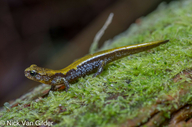|
Plethodon vandykei Van Denburgh, 1906
Van Dyke's Salamander Subgenus: Hightonia | family: Plethodontidae subfamily: Plethodontinae genus: Plethodon |
 © 2020 Nick Van Gilder (1 of 10) |
|
|
|
Description Distribution and Habitat Country distribution from AmphibiaWeb's database: United States U.S. state distribution from AmphibiaWeb's database: Washington
Life History, Abundance, Activity, and Special Behaviors Only six nests of Van Dyke's salamanders have been discovered. The first was described as a "grape-like cluster" attached by a common pedicel to a moss-covered stone in a damp location (Noble 1925) and the second was located inside a partially rotted log (85 cm in diameter and 5 m in length) in an old-growth forest on a north-northeast facing slope, near a small headwater stream (Jones 1989). Four additional nests were found in logs near undisturbed or protected streams during the summer of 1997, in the Olympic Peninsula (Blessing et al. 1999). Three of those four nests were located in old-growth forest (western hemlock and Pacific silver fir), while one was located inside a buffer of old trees in a clear-cut area. The four clutches were all found in cavities in sapwood, 6.5-7.0 cm below the surface of large decaying moss-covered conifer logs, and were each attended by an adult salamander (likely female). Clutches were left in the logs and took 144 days of observation to hatch, a much longer period than reported for other species of Plethodon (generally about 45-90 days, according to Petranka 1998). Not much is known about the natural history of this species. Adults are most active in the spring and fall months, but individuals are not commonly encountered (Petranka 1998). Trends and Threats Possible reasons for amphibian decline General habitat alteration and loss Comments
References
Blessing, B.J., Phenix, E.P., Jones, L. and Raphael, M.G. (1999). ''Nests of the Van Dyke's salamander (Plethodon vandykei) from the Olympic Peninsula, Washington.'' Northwestern Naturalist, 80, 77-81. Brodie, E. D., Jr. (1970). "Western salamanders of the genus Plethodon: Systematics and geographic variation." Herpetologica, 26(4), 468-516. Brodie, E. D., Jr., and Storm, R. M. (1970). ''Plethodon vandykei Van Denburgh. Van Dyke's Salamander.'' Catalogue of American Amphibians and Reptiles. American Society of Ichthyologists and Herpetologists, 91.1-91.2. Carstens, B. C., Stevenson, A. L., Degenhardt, J. D., and Sullivan, J. (2004). ''Testing nested phylogenetic and phylogeographic hypotheses in the Plethodon vandykei species group.'' Systematic Biology, 53, 781-792. Collins, J. T. (1991). "A new taxonomic arrangement for some North American amphibians and reptiles." Herpetological Review, 22, 42-43. Hammerson, G. 2004. Plethodon vandykei. In: IUCN 2010. IUCN Red List of Threatened Species. Version 2010.4. www.iucnredlist.org. Downloaded on 13 March 2011. Highton, R., and Larson, A. (1979). "The genetic relationships of the salamanders of the genus Plethodon." Systematic Zoology, 28, 579-599. Howard, J. H., Seeb, L. W., and R. L. Wallace (1993). "Genetic variation and population divergence in the Plethodon vandykei group (Caudata: Plethodondidae)." Herpetologica, 49, 238-247. Jones, L. L. C. (1989). ''Plethodon vandykei (Van Dyke's Salamander). Reproduction.'' Herpetological Review, 20, 48. Lynch, J. E., Jr., and Wallace, R. L. (1987). ''Field observations of courtship behavior in Rocky Mountain populations of Van Dyke's Salamander, Plethodon vandykei, with a description of its spermatophore.'' Journal of Herpetology, 21, 337-340. McIntyre, A. P., Schmitz, R.A., and Crisafulli, C.M. (2006). ''Associations of the Van Dyke’s Salamander (Plethodon vandykei) with geomorphic conditions in Headwall Seeps of the Cascade Range, Washington State.'' Journal of Herpetology, 40, 309-322. Nussbaum, R. A., Brodie, E. D., Jr., and Storm, R. M. (1983). Amphibians and Reptiles of the Pacific Northwest. University of Idaho Press, Moscow, Idaho. Petranka, J. W. (1998). Salamanders of the United States and Canada. Smithsonian Institution Press, Washington D.C. and London. Stebbins, R. C. (1985). A Field Guide to Western Reptiles and Amphibians. Houghton Mifflin, Boston. Welch, H. H., Jr. (1990). "Relictual amphibians and old-growth forests." Conservation Biology, 4, 309-319. Originally submitted by: Meredith J. Mahoney (first posted 2000-07-22) Edited by: Kellie Whittaker (2011-03-12) Species Account Citation: AmphibiaWeb 2011 Plethodon vandykei: Van Dyke's Salamander <https://amphibiaweb.org/species/4156> University of California, Berkeley, CA, USA. Accessed Jun 3, 2025.
Feedback or comments about this page.
Citation: AmphibiaWeb. 2025. <https://amphibiaweb.org> University of California, Berkeley, CA, USA. Accessed 3 Jun 2025. AmphibiaWeb's policy on data use. |



 Raffaëlli Account
Raffaëlli Account Map of Life
Map of Life